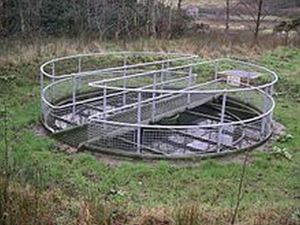 Tel Aviv, December 8 – Intelligence officials alerted the Israeli military and political leadership this morning that the Gaza Strip has begun accumulating millions of gallons of untreated sewage for an as-yet-unclear use.
Tel Aviv, December 8 – Intelligence officials alerted the Israeli military and political leadership this morning that the Gaza Strip has begun accumulating millions of gallons of untreated sewage for an as-yet-unclear use.
Mossad and military intelligence units discovered the stockpiles of the dangerous material through analysis of overhead drone images. The photographs indicated the presence of facilities for handling, storing, and channeling the mostly fluid biohazard, most of them in plain sight.
If accurate, the information represents an escalation of Hamas’s use of civilians as military assets. In the last several conflicts with Israel, the movement placed its combat and logistical facilities in or very close to civilian homes and establishments, aiming to capitalize on the images of the maimed and dead to generate sympathy and create international pressure on Israel to make concessions. The sewage, however, means a new and more insidious manifestation of the phenomenon: not only is the toxic material stored cheek-by-jowl with residential dwellings, it is produced by those very civilians – meaning that Hamas has moved from simply exploiting the presence of civilians to actively using them in military manufacturing.
The strategy poses complex dangers unprecedented in scope for Israeli military operations, say experts. “The images of bombed-out homes and of dead children are a bad enough libel for Israel to face, but this makes it even worse,” says Asla Pekukah of the Interdisciplinary Center in Hertzeliya. “Imagine a strike against a sewage stockpile and the horror that results.”
Sewage hazards have hit Gaza before. Strained infrastructure for waste management have occasionally buckled, causing torrents of the foulness to flood homes, streets, and shops. Palestinians blame Israel for not allowing the necessary materials for repairing and maintaining the facilities into Gaza, while Israel fears the metal piping will again be diverted for the production of rockets, and insists other materials are available for the sewage management.
An intensified version of that argument would likely follow any Israeli attempt to destroy the sewage, an operation that would almost inevitably fail to eliminate the waste entirely and would scatter it over a wide area. The public health disaster that represents would provide a political and diplomatic coup for Hamas, which would use the incident or incidents to paint Israel as hell-bent on harming Gaza’s civilian population, not defense.
Israel’s options remain murky. An international effort to reduce the sewage stockpiles in Gaza would almost certainly fail, as Hamas controls all official aspects of Gazan life and would make its administration of the sites a prerequisite for allowing any such project to proceed, presumably diverting some of the sewage to its own ends.



